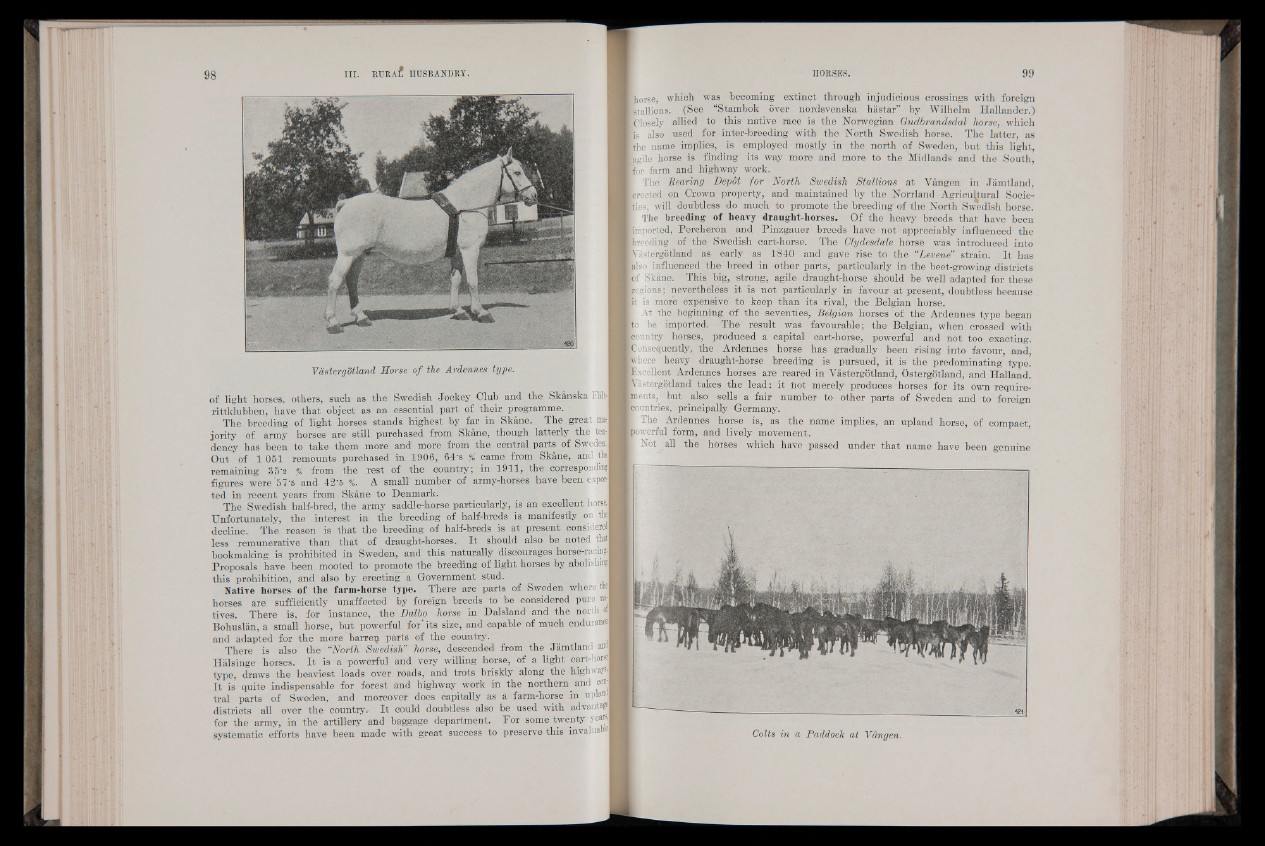
Vastergotland. Horse o f the. Ardermeli type.
of light horses, others, such as the Swedish Jockey Club and the Skanska Fait-!
rittklubben, have that object as an essential part of their programme.
The breeding of light horses stands highest by far in Skane. The great ma-l
jority of army horses are still purchased from' Skane, though latterly the ten-1
dency has been to take them more and' more from the central parts of Sweden.1
Out of 1 051 remounts purchased in 1906, 64’S % came from Skane, and thi
remaining 35'2 % from the rest o f the country;.; in 1911; the .corresponding!
figures were 5 7’5 and 42'5 %. A small number of army-horses have been exporl
ted in recent years from Skane to Denmark.
The Swedish half-bred, the army saddle-horse particularly, is an excellent horseJ
Unfortunately, the interest in the breeding of half-breds is manifestly on tie!
decline. The reason is that the breeding of half-breds is at present considered!
less remunerative than that of draught-horses. It should also, be noted that!
bookmaking is prohibited in Sweden, and this naturally discourages horse-racirgij
Proposals have been mooted to promote the breeding of light horses by abolish«
this prohibition, and also by erecting a Government stud.
Native horses of the farm-horse type. There are parts of Sweden whfere the
horses are sufficiently unaffected by foreign breeds to be considered pure natives.
There is, for instance, the Dalbo horse in Dalsland and the north A
Bohuslan, a small horse, but powerful for’its size, and capable of much endurance
and adapted for the more harrejj parts of the country.
There is also the “North Swedish” horse, descended from the Jamtland
Halsinge horses. It is a powerful and very willing horse, of a light cart-horsej
type, draws the heaviest loads over roads, and trots briskly along the highwaysj
It is quite indispensable for forest and highway work in the northern and ceti
tral parts of Sweden, and moreover does capitally as a farm-horse in UpkmJ
districts all over the country.- It could doubtless also be used with ad v an tag |
for the army, in the artillery and baggage department. For some twenty yeaBi
systematic efforts have been made with great success to preserve this invaluably
(horse, which was becoming extinct through injudicious crossings with foreign
(stallions. (See “Stambok over nordsvenska hastar” by Wilhelm Hallander.)
(Closely allied to this native race is the Norwegian Gudbrandsdal horse, which
i s also ■ used for inter-breeding with the North Swedish horse. The latter, as
■the name implies, is employed mostly in the north of Sweden, but this light,
r agile horse is finding its way more and more to the Midlands and the South,
[for farm and highway work.
1 The Rearing Depot for North Swedish Stallions at Vangen in Jamtland,
[erected on Crown property, and maintained by the Norrland Agricultural Societies,
will doubtless do much to- promote the breeding of the North Swedish horse.
[ The breeding of heavy draught-horses. Of the heavy breeds that have been
imported, Percheron and Pinzgauer breeds have not appreciably influenced the
(breeding of the Swedish cart-horse. The Clydesdale horse was introduced into
(Vastergotland as early as 1840 and gave rise, to the “Levene” strain. It has
[also influenced the'breed in other parts, particularly in the beet-growing districts
lof Skane. This big, strong, agile draught-horse should be well adapted for these
I regions; nevertheless it is not particularly in favour at present, doubtless because
Kt is more expensive to keep than its rival, the Belgian horse.
E At the beginning of the seventies, Belgian horses of the Ardennes type began
[to be imported. The result was favourable; the Belgian, when crossed with
i country horses, produced a capital cart-horse, powerful and not too exacting.
(Consequently, the Ardennes horse has gradually been rising into favour, and,
where heavy draught-horse . breeding is pursued, it is the predominating type.
Excellent Ardennes horses are reared in Vastergotland, Ostergotland, and Halland.
(Vastergotland takes the lead: it not merely produces horses for its own requirements,
but also sells a fair number to other parts of Sweden and to foreign
bountries, principally Germany.
I The Ardennes horse is, as the name implies, an upland horse, of compact,
powerful form, and lively movement.
[Not all the horses which have passed under that name have been genuine
Colts in a Paddock at Vângen.